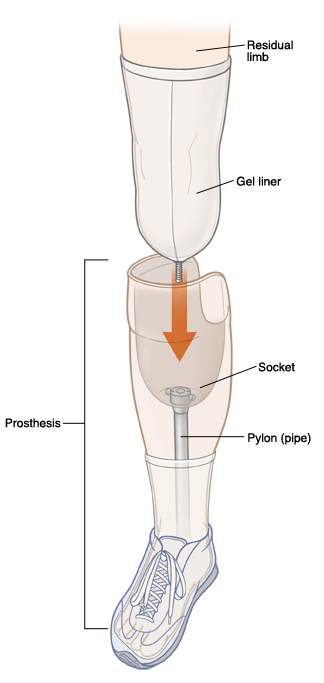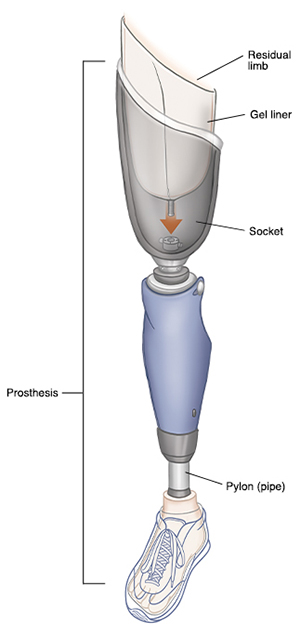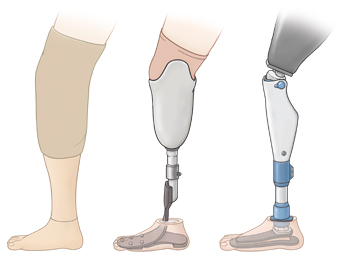Learning to Use a Prosthesis
Once your wound has healed, you may be ready for a prosthesis (artificial leg). A prosthesis can help you regain the ability to walk. You’ll start by working with a prosthetist. This is an expert who makes and fits the prosthesis. At first, you may be fitted with a preparatory or temporary prosthesis. Later, you’ll get your definitive or permanent prosthesis. In some cases, the preparatory prosthesis will serve as the definitive prosthesis. Your activity level and goals help decide the type of definitive prosthesis that will be best for you.
The parts of the preparatory prosthesis
The preparatory prosthesis is fairly basic in design. It has a socket, which fits around your residual limb. The socket is attached to a pylon (pipe) that supports your limb. Or, the socket may lead to a kneelike joint, if needed. The pylon then extends down to a solid foot piece. The foot piece has a cover that makes it look more like a natural foot.
 |
| Below-the-knee prosthesis. |
 |
| Above-the-knee prosthesis. |
Fitting the prosthesis
The prosthetist will work with you to craft a socket that fits your residual limb. A model of your limb will be made to customize the socket fit.
By the first fitting, you’ll have been wearing a shrinker sock daily. This is to help shape your residual limb. Your limb will continue to change in volume (size) as you work with the preparatory prosthesis. As volume changes, the socket must still fit securely. To make sure the socket always fits, you’ll be taught to add sock ply (thickness) using special prosthetic socks. This is the basis of good socket fit. Work with your prosthetist to learn how to adjust sock ply at home.
You’ll likely be told to maintain a stable body weight. This is because even small weight changes can affect the fit of your prosthesis.
The prosthetist will teach you to slowly increase the amount of time you wear your prosthesis each day. Follow this “wearing schedule” as directed.
Learning to walk
You may work with both your prosthetist and physical therapist to practice gait training. This means learning to walk with your prosthesis. You’ll likely start by learning to stand using parallel bars. The bars help you get used to putting weight on your prosthesis. Then you’ll progress to slow walking, using the bars for support. When you’re ready, you’ll practice walking with an aid, such as a walker or cane.
Getting your definitive prosthesis
You’ll get a definitive prosthesis when your residual limb volume is stable. It may take 6 to 12 months until you're ready. Even with a definitive prosthesis, you'll still have to adjust sock ply as needed. The type of prosthesis you get will depend on your health and special needs. You may continue to use the preparatory prosthesis, having it serve as your definitive prosthesis. Your definitive prosthesis may have:

Prosthesis care and maintenance
The socket of your prosthesis may need to be replaced every 2 to 8 years. And parts of the prosthesis can be changed if they're not meeting your needs.
Wear clean prosthetic socks every day to help prevent skin problems. Wash your socks and socket liner (depending on type) as directed by the manufacturer.
Watch for signs of poor fit
Proper fit of your prosthesis is key to its comfort and good function. Watch for signs that your prosthesis needs adjusting. Contact your prosthetist if you notice:
-
Your prosthesis feels heavy or hard to move. This may mean it's too loose.
-
Blisters or open sores on your residual limb. The prosthesis may be too loose or too tight in certain places. If this happens, stop wearing the prosthesis until you see the prosthetist. You may also need to see your healthcare provider to treat wounds or skin problems.
-
Your residual limb moves up and down within the socket as you walk. Called pistoning, this means your prosthesis is too loose. Your limb should fit snugly into the socket of the prosthesis.